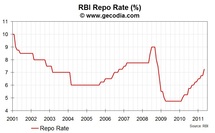
The RBI decided to hike its interest rates by 50 bp in May, pushing the India’s repo rate to 7.25% (reverse repo: 6.25%). It is the sharpest upward move since July 2010, as the RBI was only hiking by 25 bp since then. Since early 2010, the repo rate has risen from 4.75% to 7.25%.
In the statement, the RBI explains that the “calibrated tightening” is no longer effective, as “the resurgence of inflation in the last quarter of last year became a matter of concern”.
Even if inflation in India is primarily pushed up by commodity prices, second round effects are visible in domestic manufactured goods (strong demand). Moreover, the RBI expects commodity prices to increase further. Consequently, “higher inflation will persist, and may indeed get worse”. Inflation expectations, important also in India, are moving up.
In the medium term, the economic activity in India should soften. However, it is crucial for the Bank that the policy-mix becomes more restrictive with a reduction of the fiscal impulse.
The conclusion of the RBI is that “current elevated rates of inflation pose significant risks to future growth. Bringing them down, therefore, even at the cost of some growth in the short-run, should take precedence”. So, despite 250 bp of hikes since 2010, there is room for manoeuvre for tighten further.
Market Impacts
Forex: the USD/INR is up (i.e. depreciation of the INR), close to 44.45 after the announcement, even if volatility is high (first plunged to 44.30 before rising to 44.45).
In the statement, the RBI explains that the “calibrated tightening” is no longer effective, as “the resurgence of inflation in the last quarter of last year became a matter of concern”.
Even if inflation in India is primarily pushed up by commodity prices, second round effects are visible in domestic manufactured goods (strong demand). Moreover, the RBI expects commodity prices to increase further. Consequently, “higher inflation will persist, and may indeed get worse”. Inflation expectations, important also in India, are moving up.
In the medium term, the economic activity in India should soften. However, it is crucial for the Bank that the policy-mix becomes more restrictive with a reduction of the fiscal impulse.
The conclusion of the RBI is that “current elevated rates of inflation pose significant risks to future growth. Bringing them down, therefore, even at the cost of some growth in the short-run, should take precedence”. So, despite 250 bp of hikes since 2010, there is room for manoeuvre for tighten further.
Market Impacts
Forex: the USD/INR is up (i.e. depreciation of the INR), close to 44.45 after the announcement, even if volatility is high (first plunged to 44.30 before rising to 44.45).
 World GDP
World GDP



